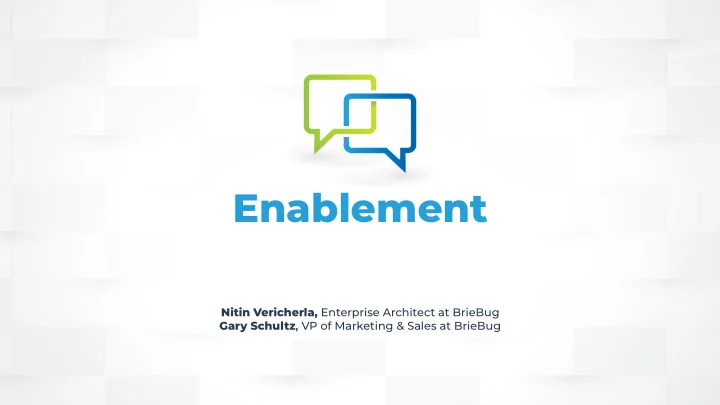

Enablement Nitin Vericherla, Enterprise Architect at BrieBug Gary Schultz , VP of Marketing & Sales at BrieBug
Key elements of enablement Enabling your organization to undertake a large initiative • Moving to a monorepo • CI pipelines • New architecture • Upgrading • Tackling technical debt
Key elements of enablement Enabling your team to achieve a higher potential • Workshops • Guidance via recommendations • Architecture work and automation • 1:1 pairing
What is not considered enabling? Siloed development Any type of siloed development by a partner leads to an eventual hand-off: since your development team was not involved during this implementation, they might very well feel one of the following: • They might not understand it: They will be hesitant to make changes, or they might make changes that lead to bugs or brittleness. • They might not agree with the implementation: They will look to re-write the implementation.
What is not considered enabling? Staff augmentation • Adding a person or a few people to your team, no matter how senior they might be, rarely leads to the entire team leveling up over time. This is because the focus is on delivery rather than knowledge sharing.
Why not do it internally? • Might create a competitive environment. • The internal resource might not have ability to devote sufficient time needed to mentor. • Need to hire or promote the right people. • The guide has no other stake than to help the team do better.
Evaluating your own readiness If we think of the engagements as a long-term series of focused phases, some of the questions to ask before the start of each phase are below: • Goals: Do we know the specific items that we want to achieve in the next phase? If we don’t then we need to schedule a brief discovery phase to determine what the specific goals are. • Survey your development teams to set the baseline. Ask about their comfort level working with the specific topics that are the focus of this engagement.
Evaluating your own readiness • Buy-in: Are the teams welcome to the idea of a development partner and guide? • Are timelines and delivery flexible to accommodate the added learning? • Is there an ongoing accumulation of technical debt without being able to address it?
Evaluating your own readiness • Availability: Do we have availability within the teams to provide the partners with time for active collaboration? • Owner: Is there a person or persons who can take responsibility for this engagement?
What to look for in a partner Evaluation is crucial for increasing the likelihood of a successful long-term engagement. • Mentorship Experience: Does the partner have previous experience with providing enablement services to organizations of your size and product maturity?
What to look for in a partner • Technical Expertise: Does the partner have the specific technical expertise that you are looking for? • Mature Collaboration: Does the partner have an internal culture of nurturing their developers?
What you can expect
Example of how to structure enablement initiatives • Long-term engagement with shorter focused efforts. • After each micro-plan is executed the partners can move to a new team or initiative.
Example of how to structure enablement initiatives
Getting the most out of the partnership • Agree on schedule: Set specific times of the day when we can rely on the partner to be immediately available. • Treat as an expert who can guide success: You’ve made an investment in expertise trust they will give you and your team the advise needed to achieve your goals and unlock the “unknown - unknowns”. • Provide them the context they need: Help them understand the industry terminology, use-cases, customer, culture, business processes, existing best-practices that are working.
What to do near the end of each initiative • Ensure that there is documentation or better yet, automation. • The team should each be able to say what was done, and be able to work with the solution that was built. • Redo the team survey. • Determine if there are any loose ends that need additional support. • Use the guide to help plan the near-term and determine when there is a window to bring them back on if needed.
TRANSLATINGTECHNOBABBLE.COM
Recommend
More recommend